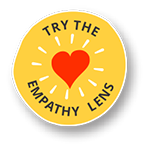Buddy Interaction
Nothing is of value unless shared!
Try the empathy lens:
Try recalling how you felt in the 1st week when you joined school. Consider how you would have felt if you had a buddy during those initial days at work and how that could have impacted your experience and emotions.
See the shift when you do have the comfort of having a ‘go to’ person, or even being able to be that person for another.
We experienced
Being aware of inclusion programs in other institutions such as the Big Brother program, we were inspired to prototype it in our own ecosystem to build a sense of community and equity.
Our Insights
-
When we started the school, the number of students was very small and working with mixed age group cohorts happened naturally and very easily. We found that this helped to nurture relationships and a culture of learning from each other.
- We found that many of the times, when children of different age groups were together, they surprised us with talents which we otherwise would not have seen.
- As the school grew and more students and teachers joined in, we realized that we wanted to retain that equity in the learning community which brought a sense of comfort and collaboration. From this purpose was born the process of Buddy Interaction.
Children understand that learning and caring for each other is not dependent on age?
We designed
A time-tabled process which
- Paired children as buddies with an age gap of four years for the most impactful interaction and engagement through the year;
- Ensured that children started feeling safe and comfortable since they found a champion in their older buddies in sessions, on the bus, playground etc.;
- Had an inbuilt component of planning and reflection to get both age groups to understand that they can learn from each other;
- Helped teachers to notice different talents of their children, which otherwise might not have been visible in the classroom.
The fallout of this process was that children felt a sense of belonging to the community of the school. It also built a mindset that there is no hierarchy of age, gender or role in learning.
Here is What we Do
This video helps make visible the process of Buddy Interaction from ‘intention’ to ‘action’.
In the video above, you will understand the relevance of the process as well as see different kinds of Buddy Interactions taking place at Riverside. Notice how teachers set the tone at the beginning and how reflections are done at the end. Alongside, you will also see some students share their experiences.
Don’t miss out on how she connects with parents by intentionally building conversations in Gujarati and Hindi :-)
Meet the Stakeholder:
Eduhero, Fozia Contractor has been an educator for over 12 years with experience of working with children of both Key Stage 2 & 3. She has a passion for reading, logical thinking and accounting, which she teaches her students through different languages of learning. Fozia is also great at helping her colleagues better their practice by training, doing observations and giving constructive feedback.
Eduhero Videos:
-
5:07
a) FAQ Video
Watch Fozia share important guidelines, strategies, and tips for planning and implementing Buddy Interaction.
-
4:28
b) Impact Video
Watch Fozia share the impact that Buddy Interaction has had on the students as well as on her own practice.
Tips for the Leader
- Begin the process in a small way, maybe by pairing just two grades. It might be a great idea to have the buddies meet informally over lunch or play time in the first month, before starting with the formal interactions.
- Help your teachers understand that this is not an added burden in the timetable, but instead a great way to create a larger community of learners and teachers.
- Recommend to teachers that over and above the time-tabled buddy interactions, they should continue to encourage informal interactions between the buddies during a visit, on the bus or even when the teachers need help in the classroom.
Share with us your experience of how you have used this process in your context, any challenges you might have faced or just inspire us with your story :-)
Still Curious?
Write us any questions you have about this process, and we’ll get back to you.
Want feedback
Upload a glimpse of your practice - a classroom video & photos of plans, resource sheets and we’ll get back to you.
Zip all your photos into one file and upload the file here
Want to Inspire ?
Upload your school’s practice as a case study to share with the world!
Document and shoot your practice in an manner that people can understand. The video should not be more than 3-5 mins.

